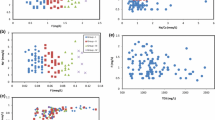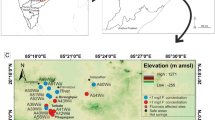Abstract
Concentrations of arsenic and fluoride above Mexican drinking water standards have been detected in aquifers of various areas of Mexico. This contamination has been found to be mainly caused by natural sources. However, the specific processes releasing these toxic elements into groundwater have been determined in a few zones only. Many studies, focused on arsenic-related health effects, have been performed at Comarca Lagunera in northern México. High concentrations of fluoride in water were also found in this area. The origin of the arsenic there is still controversial. Groundwater in active mining areas has been polluted by both natural and anthropogenic sources. Arsenic-rich minerals contaminate the fractured limestone aquifer at Zimapán, Central México. Tailings and deposits smelter-rich fumes polluted the shallow granular aquifer. Arsenic contamination has also been reported in the San Antonio–El Triunfo mining zone, southern Baja California, and Santa María de la Paz, in San Luis Potosí state. Even in the absence of mining activities, hydrogeochemistry and statistical techniques showed that arsenopyrite oxidation may also contaminate water, as in the case of the Independencia aquifer in the Mexican Altiplano. High concentrations of arsenic have also been detected in geothermal areas like Los Azufres, Los Humeros, and Acoculco. Prevalence of dental fluorosis was revealed by epidemiological studies in Aguascalientes and San Luis Potosí states. Presence of fluoride in water results from dissolution of acid-volcanic rocks. In Mexico, groundwater supplies most drinking water. Current knowledge and the geology of Mexico indicate the need to include arsenic and fluoride determinations in groundwater on a routine basis, and to develop interdisciplinary studies to assess the contaminant’s sources in all enriched areas.
Similar content being viewed by others
References
Alarcón-Herrera, M. T., Flores-Montenegro, I., Romero-Navar, P., Martín-Domínguez, I. R., & Trejo-Vázquez, R. (2001a). Contenido de arsénico en el agua potable del valle del Guadiana, México. Ingeniería Hidráulica en México, XVI, 63–70.
Alarcón-Herrera, M. T., Martín-Domínguez, I. R., Trejo-Vázquez, R., & Rodríguez-Dosal, S. (2001b). Well water fluoride, dental fluorosis, bone fractures in the Guadiana Valley of Mexico. Fluoride, 34, 139–149.
Armienta, M. A., Rodriguez, R., Aguayo, A., Ceniceros, N., Villaseñor, G., & Cruz, O. (1997a). Arsenic contamination of groundwater at Zimapán, México. Hydrogeology Journal, 5, 39–46.
Armienta, M. A., Rodriguez, R., & Cruz, O. (1997b). Arsenic content in hair of people exposed to natural arsenic polluted groundwater at Zimapán, México. Bulletin of Environmental Contamination and Toxicology, 59, 583–589.
Armienta, M. A., Villaseñor, G., Rodríguez, R., Ongley, L. K., & Mango, H. (2001). The role of arsenic-bearing rocks in groundwater pollution at Zimapán Valley, México. Environmental Geology, 40, 571–581.
Birkle, P., & Merkel, B. (2000). Environmental impact by spill of geothermal fluids at the geothermal field of Los Azufres, Michoacán, Mexico. Water, Air, and Soil Pollution, 124, 371–410.
Cardona, B. A., Carrillo R. J. J., & Armienta, H. M. A. (1993). Elemento traza: contaminación y valores de fondo en aguas subterráneas de San Luis Potosí, SLP, México. Geofísica Internacional, 32, 277–286.
Carrillo, J. J., & Armienta, M. A. (1989). Diferenciación de la contaminación inorgánica en las aguas subterráneas del Valle de la ciudad de San Luis Potosí, S.L.P., México. Geofísica Internacional, 28, 763–783.
Carrillo-Chávez, A., Drever, J. I., & Martínez, M. (2000). Arsenic content and groundwater geochemistry of the San Antonio-El Triunfo, Carrizal and Los Planes aquifers in southernmost Baja California, Mexico. Environmental Geology, 39, 1295–1303.
Carrillo-Rivera, J. J., Cardona, A., & Moss, D. (1996). Importance of the vertical component of groundwater flow: A hydrogeochemical approach in the valley of San Luis Potosí, Mexico. Journal of Hydrology, 23, 23–44.
Carrillo-Rivera, J. J., Cardona, A., & Edmunds, W. M. (2002). Use of abstraction regime and knowledge of hydrogeological conditions to control high-fluoride concentration in abstracted groundwater: San Luis Potosí Basin, Mexico. Journal of Hydrology, 261, 24–47.
Castro-Larragoitia, J., Krama, U., & Puchelt, H. (1997). 200 years of mining activity at La Paz/San Luis Potosí/Mexico-Consequences for environment and geochemical exploration. Journal of Geochemical Exploration, 58, 81–91.
Cebrián, M. E., Albores, A., García-Vergas, G., & Del Razo, L. M. (1994). Chronic arsenic poisoning in humans: The case of Mexico. In: J. O. Nriagu (Ed.), Arsenic in the environment Part II (pp. 93–107). New York: Wiley.
COREMI. (2004). Anuario Estadístico de la Minería Mexicana 2003. Pachuca: Consejo de Recursos Minerales, 252 pp.
CNA, Comisión Nacional del Agua. (2004). Statistics on water in Mexico 2004. México, D.F.: Comisión Nacional del Agua, 141 pp.
Del Razo, L. M., Arellano, M. A., & Cebrián, M. E. (1990). The oxidation states of arsenic in well-water from a chronic arsenicism area of northern Mexico. Environmental Pollution, 64, 143–153.
Del Razo, L. M., Corona, J. C., García-Vargas, G., Albores, A., & Cebrián, M. E. (1993). Fluoride levels in well-water from a chronic arsenicism area of northern Mexico. Environmental Pollution, 80, 91–94.
Del Razo L. M., Garcia-Vargas G. G., García-Salcedo J., Sanmiguel M. F., Rivera M., Hernandez M. C., & Cebrian M. E. (2002). Arsenic levels in cooked food and assessment of adult dietary intake of arsenic in the Region Lagunera, Mexico. Food and Chemical Toxicology, 40, 1423–1431.
EPA, Environmental Protection Agency. (1988). Risk Assessment Forum, Special Report on Ingested Inorganic Arsenic: Skin Cancer Nutritional Essentiality. EPA/625/3-87/013.
García, S., & Querol, S. F. (1988). Descripción de algunos yacimientos del distrito de Zimapán, Hidalgo. In: G. P. Salas (Ed.), Geología económica de México (pp. 383–400). México, D.F.: Fondo de Cultura Económica.
Gómez-Arroyo, S., Armienta, M. A., Cortés-Eslava, J., & Villalobos-Pietrini, R. (1997). Sister chromatid exchanges in Vicia faba induced by arsenic-contaminated drinking water from Zimapan, Hidalgo, Mexico. Mutation Research, 394, 1–7.
Gonsebatt, M. E., Vega, L., Salazar, A. M., Montero, R., Guzmán P., Blas, J., Del Razo, L. M., García-Vargas, G., Albores, A., Cebrián, M. E., Kelsh, M., & Ostrosky-Wegman, P. (1997). Cytogenetic effects in human exposure to arsenic. Mutation Research, 386, 219–228.
González-Hita, L., Sánchez, L., & Mata, I. (1991). Estudio hidrogeoquímico e isotópico del acuífero granular de la Comarca Lagunera. Morelos: Instituto Mexicano de Tecnología del Agua.
González-Partida, E., Hinojosa, T. E., & Verma, M. P. (2001). Interacción agua geotérmica-manantiales en el campo geotérmico de Los Humeros, Puebla, México. Ingeniería Hidráulica en México, XVI, 185–194.
Grimaldo, M., Borja-Aburto, V. H., Ramírez, A. L., Ponce, M., Rosas, M., & Díaz-Barriga, F. (1995). Endemic fluorosis in San Luis Potosí, Mexico. Environmental Research, 68, 25–30.
Gutiérrez-Pizano, A., Rodríguez, R. E., Romero, G. J., & Velázquez, G. A. (1996). Eliminación del arsénico en agua potable de pozos. Actas INAGEQ, 2, 319–322.
Hernández-Montoya, V., Bueno-López, J. I., Sánchez-Ruelas, A. M., García-Servín, J., Trejo-Vázquez, R., Bonilla-Petriciolet, A., & Márquez-Algara, C. (2003). Fluorosis y caries dental en niños de 9 a 11 años del estado de Aguascalientes, México. Revista Internacional de Contaminacion Ambiental, 19, 197–204.
Hernández-Zavala, A., Del Razo, L. M., Aguilar, C., García-Vargas, G. G., Borja, V. H., & Cebrián, M. E. (1998). Alteration in bilirubin excretion in individuals chronically exposed to arsenic in Mexico. Toxicology Letters, 99, 79–84.
IDF, Internacional Dairy Federation. (1986). Levels of trace elements in milk and milk products. Questionnaire 2386/E. Brussels.
INEGI, Instituto Nacional de Estadística, Geografía e Informática. (2000). XII Censo General de Población y Vivienda. Retrieved February 15, 2006, from: http://www.inegi.gob.mx.
Mahlknecht, J., Steinich, B., & Navarro de León, I. (2004). Groundwater chemistry and mass transfers in the Independence aquifer, central Mexico, by using multivariate statistics and mass-balance models. Environmental Geology, 45, 781–795.
Megaw, P. (1999). The high temperature Ag-Pb-Zn-(Cu) Carbonate-replacement deposits of Central Mexico. In: J. L. Jambor (Ed.), VMS and carbonate-Hosted polymetallic deposits of Central Mexico (pp. 25–40). Vancouver: British Columbia and Yukon Chamber of Miner.
Méndez, M., & Armienta, M. A. (2003). Arsenic phase distribution in Zimapán mine tailings, Mexico. Geofísica Internacional, 42, 131–140.
Molina, M. A. (2004). Estudio hidrogeoquímico en la Comarca Lagunera, México. M.Sc. Thesis, Posgrado en Ciencias de la Tierra, National Autonomous University of Mexico, UNAM, México D.F.
Ng, J. C., Wang, J., & Shraim, A. (2003). A global health problem caused by arsenic from natural sources. Chemosphere, 52, 1353–1359.
Ongley, L. K., Armienta, A., & Mango, H. (2003). Concentrations of heavy metals in soil, Zimapan, México. Journal de Physique IV, 107, 983–986.
Ortega-Guerrero, M. A. (2004). Origin of high concentrations of arsenic in groundwater at the “La Laguna Region”, northern Mexico, and implications on aquifer management. In Workshops: Program with Abstracts, 32nd IGC Florence, p. 1486.
Ortiz, D., Castro, L., Turrubiartes, F., Milan, J., & Diaz-Barriga, F. (1998). Assessment of the exposure to fluoride from drinking water in Durango, Mexico, using a geographic information system. Fluoride, 31, 183–187.
Piñón-Miramontes, M., Bautista-Margulis, R. G., & Pérez-Hernández, A. (2003). Removal of arsenic and fluoride from drinking water with cake alum and a polymeric anionic flocculent. Fluoride, 36, 122–128.
Planer-Friedrich, B., Armienta, M. A., & Merkel, B. J. (2001). Origin of arsenic in the groundwater of the Rioverde basin, Mexico. Environmental Geology, 40, 1290–1298.
Quinto, A., Santoyo, E., Torres, V., González, E., & Castillo, D. (1995). Estudio geoquímico-ambiental de los efluentes naturales producidos en la zona geotérmica de Acoculco, Puebla. Ingeniería Hidráulica en México X, 21–27.
Razo, I., Carrizales, L., Castro, J., Díaz-Barriga, F., & Monroy, M. (2004). Arsenic and heavy metal pollution of soil, water and sediments in a semi-arid climate mining area in Mexico. Water, Air, and Soil Pollution, 152, 129–152.
Rodríguez, R., Armienta, A., Berlín, J., & Mejía, J. A. (2001). Arsenic and lead pollution of the Salamanca aquifer, Mexico: Origin, mobilization and restoration alternatives. In: S. F. Thornton & S. E. Oswald (Eds.), Groundwater quality: Natural and enhanced restoration of groundwater pollution (pp. 561–565). Proceedings of the Groundwater Quality 2001, Sheffield U.K., IAHS Publ 275, Wallingford, Oxfordshire.
Rodríguez, R., Ramos, J. A., & Armienta, M. A. (2004). Groundwater arsenic variations: The role of local geology and rainfall. Applied Geochemistry, 19, 245–250.
Rodríguez, R., Armienta, M. A., & Mejía Gómez, J. A. (2005). Arsenic contamination of the Salamanca aquifer system in Mexico: A risk analysis. In: J. Bunduschuh, P. Bhattacharya, & D. Chandrasekharam (Eds.), Natural arsenic in groundwater: Occurrence, remediation and management (pp. 77–83). London: Taylor & Francis Group.
Romero, F. M., Armienta, M. A., Villaseñor, G., & González, J. L. (2006). Mineralogical constraints on the mobility of arsenic in tailings from Zimapán, Hidalgo, Mexico. International Journal of Environment and Pollution, 26, 23–40.
Rosas, I., Belmont, R., Armienta, A., & Baez, A. (1999). Arsenic concentrations in water, soil, milk and forage in Comarca Lagunera, Mexico. Water, Air, and Soil Pollution, 112, 133–149.
Simons, S. F., & Mapes-Vazquez, V. E. (1956). Geology and ore deposits of the Zimapán Mining District, State of Hidalgo, Mexico. US Geological Survey Professional Paper 284.
Smedley, P. L., & Kinniburgh, D. G. (2002). A review of the source, behaviour and distribution of arsenic in natural waters. Applied Geochemistry, 17, 517–568.
Villaseñor, C. M. G., Petersen, E. U., Avendaño-Cano, S., Gomez-Caballero, J. A., Sousa, J., & Reyes-Salas, A. M. (1996). Minerales del grupo de la tetrahedrita en las minas de Lomo de Toro y Las Animas, Zimapán, Hidalgo. Actas INAGEQ, 2, 129–134.
Wyatt, C. J., Fimbres, C., Romo, L., Méndez, R. O., & Grijalva, M. (1998a). Incidence of heavy metal contamination in water supplies in Northern Mexico. Environmental Research A, 76, 114–119.
Wyatt, C. J., Lopez, Q. V., Olivas, A. R. T., & Méndez, R. O. (1998b). Excretion of arsenic (As) in urine of children, 7–11 years, exposed to elevated levels of As in the City water supply in Hermosillo, Sonora, México. Environmental Research A, 78, 19–24.
Yáñez, L., García-Nieto, E., Roas, E., Carrizales, L., Mejía, J., Calderón, J., Razo, I., & Díaz-Barriga, F. (2003). DNA damage in blood cells from children exposed to arsenic and lead in a mining area. Environmental Research, 93, 231–240.
Author information
Authors and Affiliations
Corresponding author
Rights and permissions
About this article
Cite this article
Armienta, M.A., Segovia, N. Arsenic and fluoride in the groundwater of Mexico. Environ Geochem Health 30, 345–353 (2008). https://doi.org/10.1007/s10653-008-9167-8
Received:
Revised:
Accepted:
Published:
Issue Date:
DOI: https://doi.org/10.1007/s10653-008-9167-8




